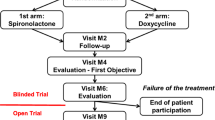Abstract
Androgens play an important role in acne vulgaris [1]. High levels of androgens and/or hypersensitivity of the sebaceous glands to normal androgen levels result in an increase of sebum production which is a prerequisite for acne in all patients [1–4].
Access this chapter
Tax calculation will be finalised at checkout
Purchases are for personal use only
Similar content being viewed by others
References
Zouboulis CC. The human skin as a hormone target and an endocrine gland. Hormones. 2004;3:9–26.
Chen WC, Zouboulis CC. Hormones and the pilosebaceous unit. Dermatoendocrinology. 2009;1:81–6.
Makrantonaki E, Ganceviciene R, Zouboulis C. An update on the role of the sebaceous gland in the pathogenesis of acne. Dermatoendocrinology. 2009;3:47–9.
Zouboulis CC. The skin as an endocrine organ. Dermatoendocrinol. 2009;1:250–2.
Zouboulis CC, Chen WC, Thorton MJ, et al. Sexual hormones in human skin. Horm Metab Res. 2007;39:85–95.
Chen W, Thiboutot D, Zouboulis CC. Cutaneous androgen metabolism: basic research and clinical perspectives. J Invest Dermatol. 2002;119:992–1007.
Dessinioti C, Katsambas AD. Hormonal therapy for acne: Why not as first line therapy? Facts and controversies. Clin Dermatol. 2010;28:17–23.
Gollnick H, Cunliffe W, Berson D, et al. Management of acne. J Am Acad Dermatol. 2003;49:S20–5.
Schmuth M, Watson RE, Deplewski D, et al. Nuclear hormone receptors in human skin. Horm Metab Res. 2007;39:96–105.
Zouboulis CC, Rabe T. Hormonal antiandrogens in acne treatment. JDDG. 2010;8:s60–74.
Zouboulis CC. Treatment of acne with anti-androgens: an evidence-based review. J Dtsch Dermatol Ges. 2003;1:535–46.
Gollnick H, Albring M, Brill K. Efficacité de l’acètate de cyprotèrone oral associé à l’ethinylestradiol dans le traitement de l’acné tardive de type facial. Ann Endocrinol. 1999;60:157–66.
Van Wayjen R, van den Ende A. Experience in the long-term treatment of patients with hirsutism and/or acne with cyproterone acetate-containing preparations: efficacy, metabolic, and endocrine effects. Exp Clin Endocrinol Diabetes. 1995;103:241–51.
Mallari R, Sinclair RD. Shortness of breath: an uncommon side-effect of cyproterone acetate in the treatment of androgenetic alopecia. Int J Dermatol. 2002;41:946–7.
Shaw JC. Low-dose adjunctive spironolactone in the treatment of acne in a retrospective analysis of 85 consecutively treated patients. J Am Acad Dermatol. 2000;43:498–502.
Akamatsu H, Zouboulis CC, Orfanos CE. Spironolactone directly inhibits proliferation of cultured human facial sebocytes and acts antagonistically to testosterone and 5-alpha-dihydrotestosterone in vitro. J Invest Dermatol. 1993;100:660–2.
Thiboutot D. Acne: hormonal concepts. Clin Dermatol. 2004;22:419–28.
Frangos J, Alavian CN, Kimball AB. Acne and oral contraceptives: update on women’s health screening guidelines. J Am Acad Dermatol. 2008;58:781–6.
Thorneycroft I. Evolution of progestins. Focus on the novel progestin drospirenone. J Reprod Med. 2002;47 Suppl 11:975–80.
Lucky AW, Henderson TA, Olson WH, et al. Effectiveness of norgestimate and ethinyl estradiol in treating moderate acne vulgaris. J Am Acad Dermatol. 1997;37:746–54.
Junkins-Hopkins JM. Hormone therapy for acne. J Am Acad Dermatol. 2010;62:486–8.
Leyden J, Shalita A, Hordinsky M, et al. Efficacy of a low-dose oral contraceptive containing 20 μg of ethinyl estradiol and 100 μg of levonorgestrel for the treatment of moderate acne: a randomized, placebo-controlled trial. J Am Acad Dermatol. 2002;47:399–409.
Thiboutot D, Archer DF, Lemay A, et al. A randomized, controlled trial of a low-dose contraceptive 20 microg of ethinyl estradiol and 100 microg of levonorgestrel for acne treatment. Fertil Steril. 2001;76:461–8.
Thomeycroft H, Gollnick H, Schellschmidt I. Superiority of a combined contraceptive containing drospirenone to a triphasic preparation containing norgestimate in acne treatment. Cutis. 2004;74:123–30.
Maloney JM, Dietze Jr P, Watson D, et al. A randomized controlled trial of a low-dose combined oral contraceptive containing 3 mg drospirenone plus 20 microg ethinylestradiol in the treatment of acne vulgaris: lesion counts, investigator ratings and subject self-assessment. J Drugs Dermatol. 2009;8:837–44.
DeRossi SS, Hersh EV. Antibiotics and oral contraceptives. Dent Clin North Am. 2002;46:653–4.
Helms SE, Bredle DL, Zajic J, et al. Oral contraceptive failure rates and oral antibiotics. J Am Acad Dermatol. 1997;36:705–10.
London BM, Lookingbill DP. Frequency of pregnancy in acne patients taking oral antibiotics and oral contraceptives. Arch Dermatol. 1994;130:392–3.
Dessinioti C, Katsambas AD. Congenital adrenal hyperplasia. Dermatoendocrinology. 2009;1:1–5.
Degitz K, Placzek M, Arnold B, et al. Congenital adrenal hyperplasia and acne in male patients. Br J Dermatol. 2003;148:1263–6.
Chen W, Zouboulis CC, Orfanos CE. The 5 alpha-reductase system and its inhibitors. Recent development and its perspective in treating androgen-dependent skin disorders. Dermatology. 1996;193:177–84.
Thiboutot D, Harris G, Iles V, et al. Activity of the type 1 5 alpha-reductase exhibits regional differences in isolated sebaceous glands and whole skin. J Invest Dermatol. 1995;105:209–14.
Zouboulis CC. Acne and sebaceous gland function. Clin Dermatol. 2004;22:360–6.
Orfanos CE, Adler YD, Zouboulis CC. The SAHA sydnrome. Horm Res. 2000;54:251–8.
Zouboulis CC, Degitz K. Androgen action on human skin-from basic research to clinical significance. Exp Dermatol. 2004;13 Suppl 4:5–10.
Author information
Authors and Affiliations
Corresponding author
Editor information
Editors and Affiliations
Rights and permissions
Copyright information
© 2014 Springer-Verlag Berlin Heidelberg
About this chapter
Cite this chapter
Dessinioti, C., Zouboulis, C.C. (2014). Hormonal Therapy for Acne. In: Zouboulis, C., Katsambas, A., Kligman, A. (eds) Pathogenesis and Treatment of Acne and Rosacea. Springer, Berlin, Heidelberg. https://doi.org/10.1007/978-3-540-69375-8_64
Download citation
DOI: https://doi.org/10.1007/978-3-540-69375-8_64
Publisher Name: Springer, Berlin, Heidelberg
Print ISBN: 978-3-540-69374-1
Online ISBN: 978-3-540-69375-8
eBook Packages: MedicineMedicine (R0)




